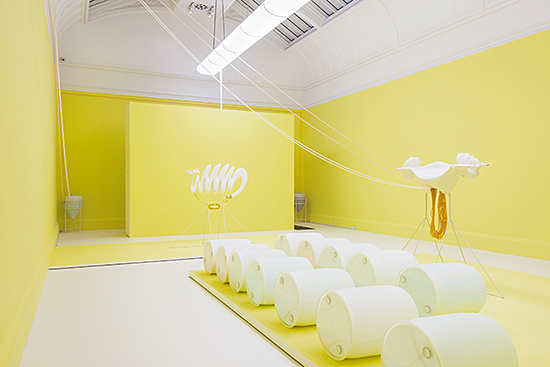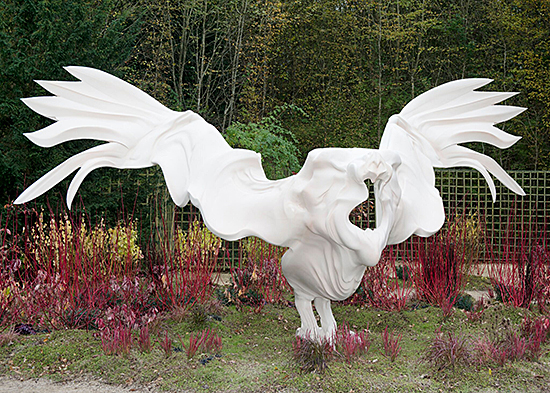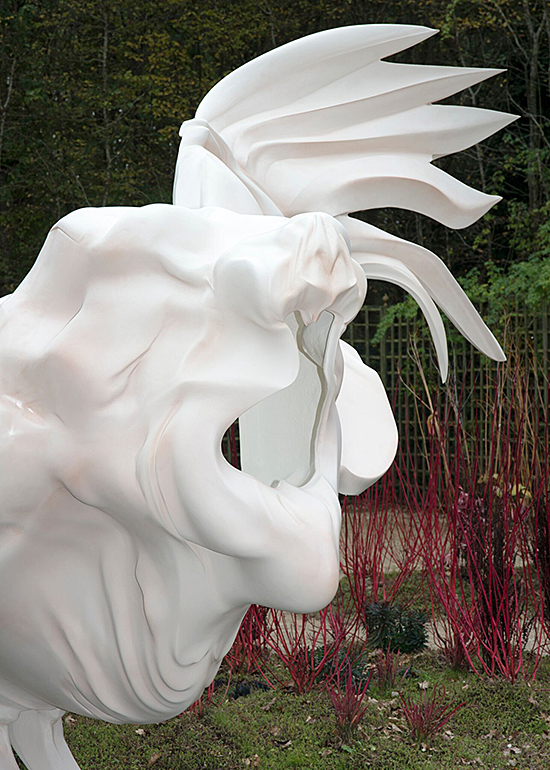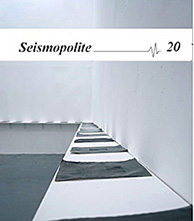Looking Past the Future
–
An interview with Marguerite Humeau
by Karen Vestergaard Andersen
The French artist Marguerite Humeau creates large-scale immersive installations serving as otherworldly scenarios for us to experience. At the moment Humeau is exhibiting her work Echoes at Tate Britain, London, as a part of Art Now, curated by Elsa Coustou and can be seen through April 15, 2018. In the installation Echoes, Humeau challenges us by means of aesthetically alluring our senses to take in the ghostliness of our time by envisioning the guts and gore of contemporary myths in the making. This way of bridging the past with vital questions of today, and turn it into a harrowing dream-scape of visual and sonic matter, forms Humeau’s imaginative and investigative art practice, placing her in a long line of talented female artists before her, honing the multifaceted field of installation art. In order to reflect on the many remarkable sides of Humeau’s work this line of questions takes a philosophical view on her practice, founded in the current approaches of New Materialism, specifically Object Oriented Ontology. These approaches help reshape our perspectives on the personal and political issues that materialize before us today, giving important insight into different ways of challenging geopolitical, cultural and historical master narratives. When we met up at Humeau’s bright studio in London, it was a chance to connect these ideas with her practice and hear her stimulating thoughts on research methods, mythmaking, speculative thinking and our world’s illusive materialism.

Karen Vestergaard (KV): I would like to start with your exhibition at Tate Britain. Could you share some thoughts on the installation Echoes and the research method behind your practice?
Marguerite Humeau (MH): The show, to put it in simple words, is a sort of fight between eternal life and death. Two polystyrene sculptures based on Ancient Egyptian goddesses and sacred animals are facing each other as a sort of staged battle between the next iteration of life and the next iteration of death. You have Wadjet, The King Cobra, injecting itself with its own venom to create an antidote, and then you have Taweret, the goddess of eternal life, who is creating an elixir. I thought the show would have to embody the building’s historical past and the strange church-like echo of the gallery - to be half temple, half laboratory. My research method has developed over the years and now I am more drawn to people inventing their own territory, testing the limits of knowledge, and thereby, questioning if scientific knowledge really is more important or more real than all these other types of knowledge. It is a sort of speculative thinking in which “bad” scientific research actually makes for good mythmaking.

KV: To paraphrase the American philosopher Graham Harman, who’s writing on object oriented ontology and immaterialist theory has influenced me quite a lot lately, I could formulate that:
In order to question the being of objects we must look instead for symbioses that mark genuine points of irreversibility, whether or not the subjects are lucid, euphoric, resolute, or heroic when they occur. How do you relate to this idea of thought?
MH: In my line of thinking, firstly you have all these worlds that co-exist, they can all be drawn back to the same, the object it incarnates. Starting with an enigma, I try to find out what kind of questions it raises in our age. I was thinking about time, and the micro and macro scale of things, the idea that all living beings are finite – all somehow myths permanently trying to remake two opponent forces. I am in a way hijacking these infinitudes by creating eternal beings, and hereby also something horrific, because what I create is not a normal biological cycle. I make prototypes that could exist forever. If you think about my installation FOXP2, what you encounter are 1:1 speculative elephants, at the same time they look like a display in a natural history museum or something quite theatrical. They are characters in a story, or like models in a car design showroom – They always shift in-between being products, animals, sculptures and ghostly beings.

KV: “The point is not to subtract humans from any given situation, but to focus on the way that humans are themselves ingredients in a symbiosis rather than just privileged observers looking on from the outside. We must remember that humans themselves are objects, and that they are richer and more momentous as objects the more they are not the mere product of their time and place, but push back against whatever circumstances they face” (*Harman, G, Immaterialism, Polity Press Molden, USA, p.55) With the quote in mind would you like to share your view on this kind of object relations with me?
MH: Yes, I think it connects to the change I felt happen when I showed my work Riddles (Sphinx Otto Protecting Earth from Humankind) last year at Versaille in France. Before I created worlds that existed outside of the human race, thus using industrial, not only aesthetics but also processes like using 3Dmodels and using different types of machines. Thinking about this quote, there was definitively a shift in the object relations I was making. With FOXP2 at Palais du Tokyo the humans were removed from the elephant world by exposing the elephants as product, sonic ghost beings etc. The humans were exposed as objects too, just in a dominant position because they are witnessing this very intimate and tragic moment, whereas later I tried to change that in the installation of the same work at Nottingham Contemporary. Here the hierarchy was lessened by a sense that all objects exist in the same sphere, making it more even, and so the battle between us and this other possible civilisation was perhaps more equal. I understood that it was key to create interactions and contact to artificial beings that we as humans have created or to “natural” beings, plants and animals that have existed long before us – to challenge our reality by embracing this inherent fragility in the relations with all objects.

KV: Your art practice cannot be categorized as overtly political, however, I still feel a strong opinionated female voice behind. The way you question origin and hierarchies of being in FOXP2 touches upon subjects of power relations and inherited racial privileges, in this case between a speculative elephant breed and humans - Are there underlying questions of a more political nature in your work?
MH: So I always try to balance everything. I aim to expose people to these worlds and invite them to make their own opinions about it, or not. I agree with the female compassionate voice. For me it is interesting conceptually to talk about re-embodiment, what makes up the thing? I am not political enough to make these strong statements, and also I don’t want to be so literal and just give correct answers, the political voice can be read into my work but it is not my overall objective. Instead I am keeping a distance and creating an overview by looking at the world through specific framings of space and time. What really interest me is to look at all these frames and patterns - looking to the future and back - thinking where are we going?
Thank you to the artist Marguerite Humeau and Tate Britain, UK.
All photos: courtesy of the artist).









